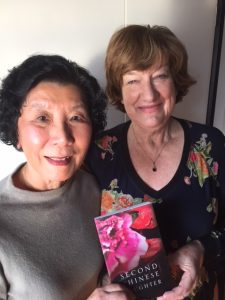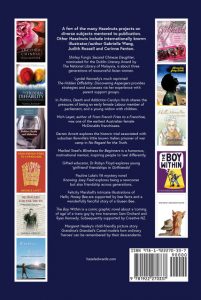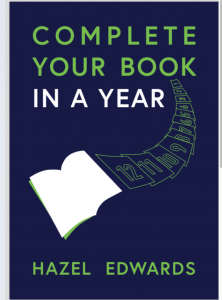Overcoming Pandemic Procrastination: Complete Your Book in a Year
by Hazel Edwards
 During the Pandemic, people are isolating, without work. But if you are healthy, you can use this surreal opportunity to work on completing your book. Decluttering memorabilia, especially photos and records often uncovers significant experiences which need recording. The Pandemic will end, but writing your book in this period can give a sense of purpose.
During the Pandemic, people are isolating, without work. But if you are healthy, you can use this surreal opportunity to work on completing your book. Decluttering memorabilia, especially photos and records often uncovers significant experiences which need recording. The Pandemic will end, but writing your book in this period can give a sense of purpose.
‘Complete Your Book in a Year’ is structured on my original face-to-face ‘master class’ course offered at the Public Records Office in North Melbourne but now Pandemic postponed. Requests came for a manual of strategies to help with writing in Lockdown.
Many meander in a maze of notes. Procrastination can cripple.
Workshopping is one solution. Mentoring via a manual is another.
The term ‘Hazelnuts’ was affectionately started by some of my former writing students and mentorees. To qualify as my ‘Hazelnut’, you have to finish and publish your writing project. ‘Hazelnuts’ are included on the back cover as inspiration that those mentored can reach publication.
Across decades, it’s satisfying to see so many books on diverse subjects which have gained from workshopping across a year. Telling the story of ‘extra-ordinary ‘ordinary heroes’ is worthwhile. So are ‘How To…’ books.
Then came the Pandemic Lockdown and postponement of f2f classes. Apart from Zooming, a 12 part manual was an attempt to keep people writing.
Mid-project I woke up with the idea of having a cover which was a compilation of Hazelnut covers. To inspire. The publisher suggested including a Schedule for the Year’s Writing needed to Complete a Book. I wrote a realistic timetable and scared even myself. But it works based on averaging 200 words per day.
Others can use the manual as a substitute for Hazelnut style workshopping in these surreal times.
There are twelve main segments which match the monthly workshops. Projects include memoir, autobiography, non-fiction, biography, fiction, graphic novels, young adult and children’s books.
What is the manual about?
Strategies to overcome ‘Procrastination’ and get your book finished.
Includes: Choosing titles, writing Conversational Table of Contents, ways to structure, characterisation (Your Turn exercises), Common Q and A, making it non-boring, use of anecdotes, mini launches and publication options.
The ‘Your Turn’ exercises are very practical.
Participants voted The Ancestor Interview as the most valuable exercise. But you’ll need an in-person or online ‘helper’ for this one.
YOUR TURN
Interview Your Ancestor (in pairs, 8 minutes each).
Become your selected ancestor and answer the interviewer’s questions as honestly as you can, even admitting to crimes. Use ‘I’ not ‘he’ or ‘she’ and get into the perspective of your character and their times.
You’ll also find out what you don’t know and need to research.
Another ‘Your Turn’ exercise:
Why Use a Conversational Table of Contents?
 Like a synopsis, a CONVERSATIONAL TABLE OF CONTENTS is a WIP (work-in-progress) tool. Usually a table of contents is used for factual works, but a conversational table of contents is midway between fiction and non-fiction and is more descriptive.
Like a synopsis, a CONVERSATIONAL TABLE OF CONTENTS is a WIP (work-in-progress) tool. Usually a table of contents is used for factual works, but a conversational table of contents is midway between fiction and non-fiction and is more descriptive.
There’s a chapter heading and some dot points, questions or phrases to entice or inform. In Victorian novels, it was a way of the character-narrator taking you into their world but characterising them at the same time.
A ‘conversational’ table of contents is a structuring device to shape your draft book and may even be included in the final version. Why use one?
- Quick check that you’ve included all the ‘bits’ and not duplicated.
- Experimenting with chapter headings to enable later use of one as the overall title.
- Gives reader an insight into tone and whether it might interest them. Indicates humour or writer’s attitude.
- Enables manipulation of chapter order for most dramatic effect.
- Helps sort out the themes of which you may be unaware.
- MAJOR value is to entice the reader with a taste of the writer’s mind and whether that appeals to them.
There are unfinished novels and memoirs out there which could share the lives of ‘real’ heroes from your family and others. Structuring and crafting helps overcome procrastination.
Step 1.
Free downloadable Schedule on ‘Complete Your Book in a Year’
https://hazeledwards.com/files//Manual/Hazels_Schedule_COMPLETE_YOUR_BOOK_IN_A_YEAR.pdf
Step 2. Start writing even a few lines.
“Writing, long term, is mentally risky but vital culturally and contributes to a non-boring life.”
― Hazel Edwards, Not Just a Piece of Cake; Being an Author
https://hazeledwards.com/complete-your-book-in-a-year.html
BookPod is the publisher. Direct link for ordering
 Hazel Edwards OAM is the author of over 200 published books, including the classic ‘There’s a Hippopotamus on our Roof Eating Cake’ series which turns 40 in 2020. By request, she has run ‘Writing a Non Boring Family History’ workshops for decades and in 2016 the Public Records Office (Vic) asked her to run the year long ‘Complete Your Book in a Year’ which was the reason for creating this manual. www.hazeledwards.com has details of her books, events and talks. Currently she is co-writing the screenplay adaptation of her adult mystery ‘Wed Then Dead on the Ghan’ with Quinn, a celebrant sleuth of diverse gender.
Hazel Edwards OAM is the author of over 200 published books, including the classic ‘There’s a Hippopotamus on our Roof Eating Cake’ series which turns 40 in 2020. By request, she has run ‘Writing a Non Boring Family History’ workshops for decades and in 2016 the Public Records Office (Vic) asked her to run the year long ‘Complete Your Book in a Year’ which was the reason for creating this manual. www.hazeledwards.com has details of her books, events and talks. Currently she is co-writing the screenplay adaptation of her adult mystery ‘Wed Then Dead on the Ghan’ with Quinn, a celebrant sleuth of diverse gender.
https://prov.vic.gov.au/about-us/our-blog/complete-your-book-2020
Free downloadable Schedule on ‘Complete Your Book in a Year’
https://hazeledwards.com/complete-your-book-in-a-year.html
Category: How To and Tips

























